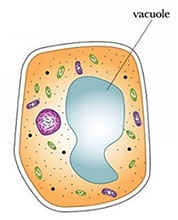
The fluid-filled or solid-filled and membrane-bounded spaces present in cells are called vacuoles. They are a kind of storage sacs. These vacuoles might store food or any variety of nutrients a cell might need to survive. In addition, it also stores waste products and protect the rest of the cell from contamination. The waste products are eventually sent out of the cell.
Vacuoles in plant cells are much large, distinct and permanent than in animal cells. That vacuole can take up more than half of the cell’s volume at times. There is usually one very large vacuole in a plant cell that has stopped growing. In mature plant cells the vacuole occupies almost the entire (i.e, 90%) volume of the cell. Because of the central position of a vacuole, the nucleus and other cell organelles in plant cells are pushed near the boundary wall. The vacuole holds onto things that the cell might need, similar to a bag. It holds large amounts of water or food as well as the plant waste products. Those waste products are slowly broken into small pieces and sent out of the cell.

In animal cells, the vacuoles if present are small and temporary. They store water, glycogen and proteins.
The structure of vacuoles begins with the membrane that surrounds a mass of fluid, in which storage of nutrients or waste products take place. Plants also use vacuoles to store water and such tiny water bags help to support the plant. They also share a bond with the objects called vesicles that are found throughout the cell.
One of the most important functions of a vacuole is support other than storage. As in, vacuoles play an important role in plant structure. We all know that plants use cell walls to provide support and surround cells, but you see the size of that cell may still increase or decrease depending on how much water is present. Same vacuoles gain and lose water depending on how much water is available to the plant.
Functions: